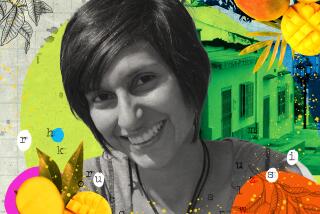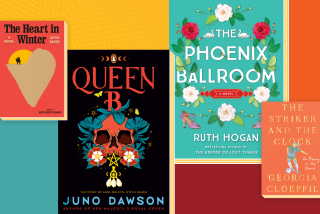BOOKS FOR KIDS
ESPERANZA RISING
Pam Munoz Ryan
Scholastic: 272 pp., $15.95
Told in a lyrical, fairy tale-like style, Pam Munoz Ryan’s robust novel set in 1930 captures a Mexican girl’s fall from riches, her immigration to California and her growing awareness of class and ethnic tensions. Thirteen-year-old Esperanza Ortega and her family are part of Mexico’s wealthy land-owning class in Aguascalientes, Mexico. Her father is a generous and well-loved man who gives his servants land and housing. Early in the novel, bandits kill Esperanza’s father, and her corrupt uncles threaten to usurp their home. Their servants help her and her mother flee to the United States, leaving Esperanza’s beloved Abuelita (grandmother) behind until they can send for her.
Ryan poetically conveys Esperanza’s ties to the land by crafting her story to the rhythms of the seasons. Each chapter’s title takes its name from the fruits Esperanza and her countrymen harvest, first in Aguascalientes, then in California’s San Joaquin Valley. Ryan fluidly juxtaposes world events (Mexico’s post-revolution tensions, the arrival of Oklahoma’s Dust Bowl victims and the struggles between the U.S. government and Mexican workers trying to organize) with one family’s will to survive. She also introduces readers to Spanish words and Mexican customs. Readers will be swept up by her vivid descriptions of California dust storms and by a police crackdown on a labor strike (“The picket signs lay on the ground, discarded, and like a mass of marbles that had already been hit, the strikers scattered. . .”). Ryan delivers subtle metaphors via Abuelita’s pearls of wisdom, and not until story’s end will readers recognize how carefully they have been strung. (Ages 9 to 14)
*
THE LONGITUDE PRIZE
By Joan Dash
Illustrated by Dusan Petricic
Farrar, Straus & Giroux/Foster: 208 pp., $16
Joan Dash pens an engrossing tale of the scientific contest for the Longitude Prize, which was offered through a 1714 act of Parliament. Opening with a gripping historical account of a shipwreck, the author sets up a compelling argument for the need to determine a vessel’s position on the open sea. Without means for determining longitude, “English ships had been sailing everywhere in the Western world, relying on charts and maps that often had little relation to reality.” The Parliament establishes the prize for “any device or invention for determining longitude” with a reward “roughly equal to $12 million today.” (Even Isaac Newton competed.) Enter unlikely contender John Harrison, a carpenter and clockmaker, “a loner, plain-spoken, often tactless, with a temper he couldn’t always control, and a genius for mechanics.” Dash spotlights Harrison’s biography as she navigates scientific and cultural history, describing the dynamics between officers and sailors. (She also mentions the role of Captain James Cook of the Endeavour in proving the worthiness of Harrison’s invention--which figures prominently in Karen Hesse’s “Stowaway,” reviewed below). Dusan Petricic’s caricature-like drawings and the ragged-edge paper lend the volume a touch of class. Dash begins with more panache than she ends with but keeps the suspense high throughout. Fans of science, history and invention and anyone who roots for the underdog will enjoy this prize of a story. (Ages 10 and up)
*
STOWAWAY
By Karen Hesse
Illustrated by Robert Andrew Parker
Simon & Schuster/McElderry: 320 pp., $17
Sparkling with humor, poignancy and adventure, Newbery Medal-winner Karen Hesse’s historical novel, told in diary form, was inspired by a real boy who stowed away aboard Captain James Cook’s ship Endeavour on its 1768 voyage. The author bases the story on what little is known about 11-year-old Nicholas Young (he could read and write, for instance, and was made an official crew member in April 1769, when the ship reached Tahiti) and spins an imaginative tale firmly anchored in fact. The brief diary entries adhere to the ship’s actual itinerary and detail Nick’s adventures (and misadventures), among them his ongoing run-ins with a vindictive midshipman (also documented), the excitement and danger of rounding Cape Horn and the captain’s disappointment in the view of Venus’ transit across the sun (one of the main reasons for the voyage). Nick grows into young manhood irrevocably shaped by the three-year voyage, teaching an illiterate shipmate to read, befriending a Tahitian boy and witnessing cannibalism while helping to nurse a crew ravaged by accident and disease. His lively observations (on seasickness: “I can say now that Gentlemen heave the contents of their stomach same as eleven-year-old stowaways”) keep the action sailing smoothly forward, while Hesse’s impeccable research buttresses the narrative with a wealth of detail. A sprinkling of Robert Andrew Parker’s pen-and-ink illustrations provides additional texture, while an author’s note and extensive glossary round out this compelling volume. (Ages 10 to 14)
*
LEONARDO AND THE FLYING BOY
By Laurence Anholt
Barron’s: 32 pp., $13.95
Laurence Anholt (“Camille and the Sunflowers”) continues his imaginative series about great artists with this cleverly executed and engaging account of one of Leonardo da Vinci’s real-life apprentices. When Leonardo tells Zoro that one day “people will sail through the clouds and look down at the world below,” the boy believes him. After all, “anything seemed possible in Leonardo’s busy studio.” But when Zoro and Salai, a mischievous urchin Leonardo has taken in, sneak into their master’s secret workshop and take his flying machine for a spin, there’s trouble ahead. The story is relayed with verve, and the spry colored-pencil drawings that detail Zoro’s escapades boast numerous comic touches (such as Leonardo nearly tripping over his oversize red slippers in his haste to get back to his studio when struck by inspiration) and sly references to Leonardo’s body of work (backward writing on the endpapers; copies of his botanical drawings, inventions and character studies; even a Mona Lisa reproduction). This is a fun-filled and accessible introduction to one of science and art history’s most fascinating figures. (Ages 4 to 8)
*
WINGS
By Christopher Myers
Scholastic: 40 pp., $16.95
Once again demonstrating a masterful use of collage, Christopher Myers imaginatively refutes the myth of Icarus and champions the nature of the artist. A watchful girl, ostracized by her peers for her quiet nature, narrates the story of her blossoming friendship with a new neighbor, Ikarus Jackson, whose “long, strong, proud wings followed wherever he went.” Ikarus initially walks (and flies) with confidence in his red T-shirt and blue shorts, but he slowly loses steam as first the students, then his teacher, and finally a policeman all criticize his unique appearance. Always depicted as a yellow silhouetted figure gracefully cut from a single piece of paper, the girl sympathizes with the hero and completes Ikarus’ medley of red and blue. In this way, Myers ingeniously allows readers to identify with the narrator, admiring Ikarus’ beauty of flight and individual expression. The artwork isolates and reworks elements of the myth: In the valley of Ikarus’ dejection (“He struggled to stay in the air. His wings dropped and his head hung low”), the boy seems to be plummeting toward an expanse of water. In the climax, as the policeman yells at Ikarus and the neighbors “explode with laughter,” Myers superimposes the boy’s figure over a scene of a forest fire, and the girl reaches out to Ikarus from across the gutter. She, too, seems to be aflame against a backdrop of swirling water--and breaks her silence for the first time. “ ‘Stop!’ I cried. ‘Leave him alone.’ ” Myers indicates that one person’s appreciating another’s true qualities makes life complete: The two friends seem to dance--he in the air, she on the ground--as their unique colors and shapes create a unified whole. (Ages 7 and up)
More to Read
Sign up for our Book Club newsletter
Get the latest news, events and more from the Los Angeles Times Book Club, and help us get L.A. reading and talking.
You may occasionally receive promotional content from the Los Angeles Times.








